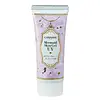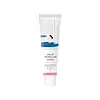What's inside
What's inside
 Key Ingredients
Key Ingredients

 Benefits
Benefits

 Concerns
Concerns

 Ingredients Side-by-side
Ingredients Side-by-side

Water
Skin ConditioningButylene Glycol
HumectantPhytic Acid
Larix Kaempferi Root Bark Extract
Skin ConditioningPEG-60 Hydrogenated Castor Oil
EmulsifyingMesua Ferrea Seed Extract
Skin ConditioningPolyhydroxystearic Acid
EmulsifyingPolymethylsilsesquioxane
Cyclopentasiloxane
EmollientHouttuynia Cordata Extract
Skin ConditioningTrihydroxystearin
Skin ConditioningVaccinium Myrtillus Fruit Extract
Skin ConditioningSilver Oxide
AntimicrobialNiacinamide
SmoothingPhenoxyethanol
PreservativeMethylheptyl Laurate
EmollientJojoba Esters
EmollientSchinus Molle Leaf Extract
Skin ConditioningXanthan Gum
EmulsifyingAluminum Hydroxide
EmollientPotassium Hydroxide
BufferingPolyglyceryl-2 Triisostearate
EmulsifyingOenothera Biennis Seed Extract
Skin ConditioningPolyglyceryl-3 Polydimethylsiloxyethyl Dimethicone
Skin ConditioningSolanum Lycopersicum Seed Extract
Skin ConditioningArginine
MaskingHydroxyethyl Acrylate/Sodium Acryloyldimethyl Taurate Copolymer
Emulsion StabilisingSalix Alba Flower Extract
Skin ConditioningPimpinella Anisum Seed Extract
AstringentDiethylamino Hydroxybenzoyl Hexyl Benzoate
UV FilterPopulus Nigra Flower Extract
Skin ConditioningTitanium Dioxide
Cosmetic ColorantBis-Ethylhexyloxyphenol Methoxyphenyl Triazine
Skin ConditioningAorta Extract
Skin ConditioningSaxifraga Sarmentosa Extract
Skin ConditioningBlue 1 Lake
Cosmetic ColorantSilica
AbrasiveAlpha-Glucan
HumectantMorus Alba Root Extract
BleachingCI 45380
Cosmetic ColorantBeta-Glucan
Skin ConditioningDimethicone
EmollientGlucosyl Ceramide
Skin ConditioningEthylhexyl Methoxycinnamate
UV AbsorberSodium Hyaluronate
HumectantAlumina
AbrasiveOctyldodecanol
EmollientPrunus Yedoensis Leaf Extract
Skin ConditioningCetyl Ethylhexanoate
EmollientDiisostearyl Malate
EmollientRosa Rugosa Leaf Extract
HumectantCI 77492
Cosmetic ColorantStearic Acid
CleansingCynara Scolymus Leaf Extract
Skin ConditioningZinc Oxide
Cosmetic ColorantParfum
MaskingSpiraea Ulmaria Flower Extract
Skin ConditioningBetula Alba Leaf Extract
AstringentSalvia Officinalis Extract
AntimicrobialTocopherol
AntioxidantWater, Butylene Glycol, Phytic Acid, Larix Kaempferi Root Bark Extract, PEG-60 Hydrogenated Castor Oil, Mesua Ferrea Seed Extract, Polyhydroxystearic Acid, Polymethylsilsesquioxane, Cyclopentasiloxane, Houttuynia Cordata Extract, Trihydroxystearin, Vaccinium Myrtillus Fruit Extract, Silver Oxide, Niacinamide, Phenoxyethanol, Methylheptyl Laurate, Jojoba Esters, Schinus Molle Leaf Extract, Xanthan Gum, Aluminum Hydroxide, Potassium Hydroxide, Polyglyceryl-2 Triisostearate, Oenothera Biennis Seed Extract, Polyglyceryl-3 Polydimethylsiloxyethyl Dimethicone, Solanum Lycopersicum Seed Extract, Arginine, Hydroxyethyl Acrylate/Sodium Acryloyldimethyl Taurate Copolymer, Salix Alba Flower Extract, Pimpinella Anisum Seed Extract, Diethylamino Hydroxybenzoyl Hexyl Benzoate, Populus Nigra Flower Extract, Titanium Dioxide, Bis-Ethylhexyloxyphenol Methoxyphenyl Triazine, Aorta Extract, Saxifraga Sarmentosa Extract, Blue 1 Lake, Silica, Alpha-Glucan, Morus Alba Root Extract, CI 45380, Beta-Glucan, Dimethicone, Glucosyl Ceramide, Ethylhexyl Methoxycinnamate, Sodium Hyaluronate, Alumina, Octyldodecanol, Prunus Yedoensis Leaf Extract, Cetyl Ethylhexanoate, Diisostearyl Malate, Rosa Rugosa Leaf Extract, CI 77492, Stearic Acid, Cynara Scolymus Leaf Extract, Zinc Oxide, Parfum, Spiraea Ulmaria Flower Extract, Betula Alba Leaf Extract, Salvia Officinalis Extract, Tocopherol
Water
Skin ConditioningDibutyl Adipate
EmollientPropanediol
SolventTitanium Dioxide
Cosmetic ColorantCaprylic/Capric Triglyceride
MaskingC12-15 Alkyl Benzoate
AntimicrobialDiethylamino Hydroxybenzoyl Hexyl Benzoate
UV FilterCaprylyl Methicone
Skin ConditioningEthylhexyl Triazone
UV AbsorberNiacinamide
SmoothingGlycerin
HumectantDiethylhexyl Butamido Triazone
UV Absorber1,2-Hexanediol
Skin ConditioningPentylene Glycol
Skin ConditioningButylene Glycol
HumectantBetula Platyphylla Japonica Juice
Skin ConditioningSodium Hyaluronate
HumectantHyaluronic Acid
HumectantGlyceryl Glucoside
HumectantPanthenol
Skin ConditioningDipotassium Glycyrrhizate
HumectantAllantoin
Skin ConditioningPortulaca Oleracea Extract
Skin ConditioningArtemisia Annua Extract
MaskingPinus Sylvestris Leaf Oil
MaskingAnthemis Nobilis Flower Oil
MaskingEthylhexylglycerin
Skin ConditioningDimethicone/Vinyl Dimethicone Crosspolymer
Skin ConditioningVp/Eicosene Copolymer
Trisiloxane
Skin ConditioningCoco-Caprylate/Caprate
EmollientSodium Polyacryloyldimethyl Taurate
Emulsion StabilisingAmmonium Polyacryloyldimethyl Taurate
Emulsion StabilisingHydroxypropyl Methylcellulose Stearoxy Ether
Dicaprylyl Carbonate
EmollientAlumina
AbrasiveAscorbic Acid
AntioxidantAdenosine
Skin ConditioningPolyhydroxystearic Acid
EmulsifyingStearic Acid
CleansingDimethiconol
EmollientSodium Polyacrylate
AbsorbentTriethoxycaprylylsilane
Pvm/Ma Copolymer
Emulsion StabilisingPolyether-1
CI 77492
Cosmetic ColorantCI 77491
Cosmetic ColorantT-Butyl Alcohol
PerfumingXanthan Gum
EmulsifyingWater, Dibutyl Adipate, Propanediol, Titanium Dioxide, Caprylic/Capric Triglyceride, C12-15 Alkyl Benzoate, Diethylamino Hydroxybenzoyl Hexyl Benzoate, Caprylyl Methicone, Ethylhexyl Triazone, Niacinamide, Glycerin, Diethylhexyl Butamido Triazone, 1,2-Hexanediol, Pentylene Glycol, Butylene Glycol, Betula Platyphylla Japonica Juice, Sodium Hyaluronate, Hyaluronic Acid, Glyceryl Glucoside, Panthenol, Dipotassium Glycyrrhizate, Allantoin, Portulaca Oleracea Extract, Artemisia Annua Extract, Pinus Sylvestris Leaf Oil, Anthemis Nobilis Flower Oil, Ethylhexylglycerin, Dimethicone/Vinyl Dimethicone Crosspolymer, Vp/Eicosene Copolymer, Trisiloxane, Coco-Caprylate/Caprate, Sodium Polyacryloyldimethyl Taurate, Ammonium Polyacryloyldimethyl Taurate, Hydroxypropyl Methylcellulose Stearoxy Ether, Dicaprylyl Carbonate, Alumina, Ascorbic Acid, Adenosine, Polyhydroxystearic Acid, Stearic Acid, Dimethiconol, Sodium Polyacrylate, Triethoxycaprylylsilane, Pvm/Ma Copolymer, Polyether-1, CI 77492, CI 77491, T-Butyl Alcohol, Xanthan Gum
 Reviews
Reviews

Ingredients Explained
These ingredients are found in both products.
Ingredients higher up in an ingredient list are typically present in a larger amount.
Alumina is another name for the compound aluminum oxide. It is used as a thickener, absorbent, and abrasive.
As an absorbent, alumina can give a mattifying effect. It is used in mineral sunscreens to help coat nano-sized filters, such as titanium dioxide. By increasing the size of the UV filters, these ingredients stay on the skin for a longer time. By coating small sized ingredients, alumina helps thicken a product.
Alumina may be used as an abrasive, or exfoliant.
Alumina is naturally occurring in the mineral corundum. Certain varieties of corundum create rubies and sapphires. Corundum is also the crystalline form of alumina.
Learn more about AluminaButylene Glycol (or BG) is used within cosmetic products for a few different reasons:
Overall, Butylene Glycol is a safe and well-rounded ingredient that works well with other ingredients.
Though this ingredient works well with most skin types, some people with sensitive skin may experience a reaction such as allergic rashes, closed comedones, or itchiness.
Learn more about Butylene GlycolCi 77492 is also hydrated iron III oxide. It's sole purpose is to give a yellow hue to products.
Iron III oxides are classified as inorganic chemicals for coloring.
Synthetically created Ci 77492 is considered safer than those naturally found. This is because the synthetically created version may contain less impurities. Iron oxides are generally non-toxic and non-allergenic.
Learn more about CI 77492Diethylamino Hydroxybenzoyl Hexyl Benzoate (DHHB) is a chemical UV-A absorber. It is formulated for high UVA protection (320-400 nm).
DHHB is well-liked for:
DHHB has been approved by the EU, Japan, Taiwan, and South America for use up to 10%. Unfortunately, it has not been approved for use in the US or Canada due to slow regulatory processes.
This ingredient is soluble in oils, fats, and lipids.
Learn more about Diethylamino Hydroxybenzoyl Hexyl BenzoateNiacinamide is a multitasking form of vitamin B3 that strengthens the skin barrier, reduces pores and dark spots, regulates oil, and improves signs of aging.
And the best part? It's gentle and well-tolerated by most skin types, including sensitive and reactive skin.
You might have heard of "niacin flush", or the reddening of skin that causes itchiness. Niacinamide has not been found to cause this.
In very rare cases, some individuals may not be able to tolerate niacinamide at all or experience an allergic reaction to it.
If you are experiencing flaking, irritation, and dryness with this ingredient, be sure to double check all your products as this ingredient can be found in all categories of skincare.
When incorporating niacinamide into your routine, look out for concentration amounts. Typically, 5% niacinamide provides benefits such as fading dark spots. However, if you have sensitive skin, it is better to begin with a smaller concentration.
When you apply niacinamide to your skin, your body converts it into nicotinamide adenine dinucleotide (NAD). NAD is an essential coenzyme that is already found in your cells as "fuel" and powers countless biological processes.
In your skin, NAD helps repair cell damage, produce new healthy cells, support collagen production, strengthen the skin barrier, and fight environmental stressors (like UV and pollution).
Our natural NAD levels start to decline with age, leading to slower skin repair, visible aging, and a weaker skin barrier. By providing your skin niacinamide, you're recharging your skin's NAD levels. This leads to stronger, healthier, and younger looking skin.
Another name for vitamin B3 is nicotinamide. This vitamin is water-soluble and our bodies don't store it. We obtain Vitamin B3 from either food or skincare. Meat, fish, wheat, yeast, and leafy greens contain vitamin B3.
The type of niacinamide used in skincare is synthetically created.
Learn more about NiacinamidePolyhydroxystearic Acid is a soft wax made from castor oil.
It is is a texture thickener, emulsifier, and film-former. Emulsifiers prevent ingredients from separating, such as oils and waters.
Polyhydroxystearic Acid may not be fungal acne safe.
Learn more about Polyhydroxystearic AcidSodium Hyaluronate is hyaluronic acid's salt form. It is commonly derived from the sodium salt of hyaluronic acid.
Like hyaluronic acid, it is great at holding water and acts as a humectant. This makes it a great skin hydrating ingredient.
Sodium Hyaluronate is naturally occurring in our bodies and is mostly found in eye fluid and joints.
These are some other common types of Hyaluronic Acid:
Learn more about Sodium HyaluronateStearic Acid is a fatty acid. It is an emollient, emulsifier, and texture enhancer.
As an emollient, stearic acid helps soften skin. It aids the skin's protective barrier by preventing water loss. It also provides a gentle cleansing effect without stripping away natural oils.
Stearic acid may also be used to enhance the texture of products. It can add volume and stabilize ingredients such as water and oil. This can help water and oil ingredients from separating.
Sources of stearic acid include animal or vegetable fats/oils such as coconut or shea. It can be naturally found in butter, cocoa butter, shea butter, vegetable fats, and animal tallow.
This ingredient may not be Malassezia folliculitis, or fungal-acne safe.
Learn more about Stearic AcidTitanium dioxide is a mineral UV filter widely used in sunscreens and cosmetics.
It is one of only two UV filters officially classified as “mineral” by regulatory agencies, the other being zinc oxide.
Titanium dioxide provides broad-spectrum protection mostly in the UVB and UVAII range, with some protection in the UVAI range.
While its UVA protection isn’t as strong as zinc oxide’s, the difference is minor.
A common myth is that mineral UV filters reflect UV light. However, modern research shows titanium dioxide absorbs UV radiation like chemical filters (~95% absorption & 5% reflection).
Thanks to its non-irritating nature, titanium dioxide is suitable for sensitive, acne-prone, or redness-prone skin. It is unlikely to cause "eye sting" like other sunscreen ingredients.
A major drawback of this ingredient is its white cast and thick texture. This is why mineral sunscreens often leave a white cast and are less cosmetically elegant than chemical/hybrid sunscreens.
To improve white cast and spreadability, micronized or nano-sized titanium dioxide is often used.
There are ongoing concerns surrounding nano-titanium oxide's impact on marine ecosystems.
There is no conclusive evidence that any form of titanium oxide (or any other sunscreen ingredients) will cause harm to marine ecosystems or coral reefs. The science is still developing but many consumers are keeping a close eye on this issue.
Please note, many destinations have reef-safety sunscreen rules. For instance, the U.S. Virgin Islands advises all visitors to use non-nano mineral sunscreens.
Nano mineral sunscreens once raised safety concerns about absorption into skin.
Extensive research has shown that they do not penetrate healthy or damaged skin; they remain safely on the surface and the top layer of dead skin (stratum corneum).
You'll likely find titanium dioxide bundled with alumina, silica, or dimethicone. These ingredients help make titanium dioxide highly photostable; this prevents it from interacting with other formula components under UV light.
Learn more about Titanium DioxideWater. It's the most common cosmetic ingredient of all. You'll usually see it at the top of ingredient lists, meaning that it makes up the largest part of the product.
So why is it so popular? Water most often acts as a solvent - this means that it helps dissolve other ingredients into the formulation.
You'll also recognize water as that liquid we all need to stay alive. If you see this, drink a glass of water. Stay hydrated!
Learn more about WaterXanthan gum is used as a stabilizer and thickener within cosmetic products. It helps give products a sticky, thick feeling - preventing them from being too runny.
On the technical side of things, xanthan gum is a polysaccharide - a combination consisting of multiple sugar molecules bonded together.
Xanthan gum is a pretty common and great ingredient. It is a natural, non-toxic, non-irritating ingredient that is also commonly used in food products.
Learn more about Xanthan Gum